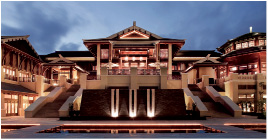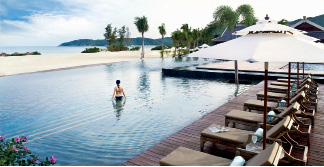- Home
- Media Kit
- Current Issue
- Past Issues
- Ad Specs-Submission
- Ad Print Settings
- Reprints (PDF)
- Photo Specifications (PDF)
- Contact Us

![]()
ONLINE

Meeting Customer Expectations
Editors’ Note
In addition to his current post, Simon Cooper is responsible for the development of Bulgari Hotels, a joint venture between Marriott International, Inc. and Bulgari S.p.A. Cooper joined The Ritz-Carlton in February 2001 from Marriott International where he served for three years as President of Marriott Lodging Canada and Senior Vice President of Marriott Lodging International responsible for Canada and New England. He began his hospitality career when he immigrated to Canada in 1972 and worked for Canadian Pacific Hotels & Resorts. In 2005, he was elected to the Board of Directors of First Horizon National Corporation. In 2004, he was appointed to the Woodrow Wilson International Center for Scholars and the Canada Institute Advisory Board. Cooper earned an M.B.A. from the University of Toronto.
Company Brief
Headquartered in Bethesda, Maryland, Marriott International, Inc. (www.marriott.com) is a leading lodging company with more than 3,500 lodging properties in 70 countries and territories. It is recognized by FORTUNE as one of the best companies to work for, and by Newsweek as one of the greenest big companies in America. In fiscal year 2009, Marriott International reported sales from continuing operations of nearly $11 billion.
How has the Asian hospitality market performed during the global economic crisis and what is your outlook for the market looking ahead?
The Asian hospitality sector, like the economies of the region, fared very well through the downturn and the future outlook is very strong with China and India leading the growth.

The Ritz-Carlton, Sanya, China Exterior
Would you highlight the strength of the different Marriott brands in Asia?
Ritz-Carlton enjoys an exceptional presence in the region with nine hotels in China and new hotels in most of the gateways.
Likewise, the JW Marriott chain, which first opened in the U.K. in 1989, has some outstanding hotels in important gateways.
Renaissance has a good pipeline and has opened 10 hotels in the region in the past five years.
Courtyard in China and Fairfield in India are both brands with a lot of traction.
How has the global economic crisis affected the luxury segment broadly and, more specifically, Ritz-Carlton?
I was always looking at other luxury items and goods and services to assess how we were doing generally across industries. In the early part of ’09, people were ready to take another vacation and, while they were looking for a greater value and being more discerning in terms of their purchases, the travel side came back relatively quickly. Through the summer of last year, that was a tremendous benefit for us.
The real hit to Ritz-Carlton was in the group business. The AIG effect, as we refer to it, was very significant – in North America, it was about 300,000 room nights. The luxury segment of the hospitality industry in 2009 did worse than all the other segments and it was primarily from the group piece coming out.

The Ritz-Carlton, Sanya, China Front Pool
However, the first five months of 2010, luxury accelerated faster than any other segment.
Luxury has somewhat of a negative perception today. Has that been overcome?
In Washington, luxury became a dirty word. It took us until the middle of 2009 to get through to the politicians that this was affecting jobs and not just in big cities. A lot of our properties are in locations where we are the largest employer and taxpayer. So when they pick on the industry and groups pull out as a result of political statements, the ones getting hurt are the lowest paid in our industry.
Was it critical from a leadership point of view during this time to put even more of an emphasis on internal communications?
Absolutely. We ramped up communications significantly. I would do a podcast every three weeks in addition to written communications. I was straightforward as to what we were seeing and we made the assessment in December ’08 that ’09 was going to be a brutal year.
Our employees did a terrific job, because despite all the challenges of ’09, our Gallup scores and guest scores went up. We won almost every piece of research or public opinion in 2009. That was 100 percent due to our staffs who had not only figured out that people, because they had less disposable income, were spending a greater percentage of their disposable income than they had previously, but also that they had choices. They weren’t staying with us because the Four Seasons was full – they were staying with us because they chose to stay with us.
Do you see growth opportunities coming out of these challenging times?
If you can handle the worst of environments and come through in better condition than your competition, you’re going to be offered opportunities and we’re already seeing that. A lot of the opportunities we’re working on today are either existing independents or existing with another brand. It will be awhile before new build picks up again, although we have some hotels opening that were started prior to the downturn. We are making progress, but for growth, we’re focusing on partnering with governments who are continuing to invest in existing properties.
Where do you foresee growth opportunities for the brands in the Asian market?
Other than China and India, there are a number of developing markets such as Indonesia and Vietnam that offer unique opportunities for growth of our brands.
What are your plans for the growth and continued leadership of the Ritz-Carlton brand?
One is being proactive globally in putting our hotels where our existing high-net-worth individuals want to go now and, more importantly, where they’ll go in the future.
Second is making sure we never lose sight of the consumer, who has been shocked going through this recession. What’s interesting is that confidence is going back up but spending isn’t. We’re probably going to have lower yields for awhile, affecting total expenditures. So we have to look at how we meet the expectations of the new consumer in an environment where he is spending less.•